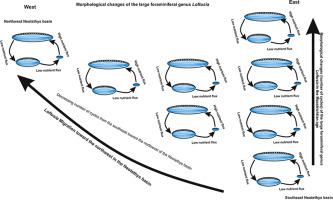当前位置:
X-MOL 学术
›
Mar. Micropaleontol.
›
论文详情
Our official English website, www.x-mol.net, welcomes your
feedback! (Note: you will need to create a separate account there.)
Morphological changes of the large foraminiferal genus Loftusia during the Maastrichtian and its palaeogeographical inferences from the Zagros and Neotethys basins
Marine Micropaleontology ( IF 1.5 ) Pub Date : 2021-01-01 , DOI: 10.1016/j.marmicro.2020.101941 Hossein Ghanbarloo , Amrollah Safari , Hossein Vaziri-Moghaddam
Marine Micropaleontology ( IF 1.5 ) Pub Date : 2021-01-01 , DOI: 10.1016/j.marmicro.2020.101941 Hossein Ghanbarloo , Amrollah Safari , Hossein Vaziri-Moghaddam

|
Abstract This study examines the morphological changes of the Loftusia genus from the Zagros Belt of southern Iran using quantitative data. Eight Tarbur Formation outcrops were investigated in the High Zagros and the Lurestan sub zones. The observed Loftusia species are of mid Maastrichtian age in the High Zagros and the mid to late Maastrichtian age in the Lurestan and Murak areas, and they are often observed in deposits of the lagoon environments with high nutrient conditions. Two (Tang-e Shabi Khoon area) and four (Murak area) cycles were recognized based on the morphological parameter changes of Loftusia species. The correlation of the number of cycles of Loftusia species between the Zagros basin and the different areas of the Neotethys basin indicates that Loftusia species sizes change in time. The obtained data shows that the number of the sedimentary cycles (alternating shale and limestone layers) in the High Zagros zone is more different than the Lurestan zone. The High Zagros zone comprises rich terrigenous shale with higher nutrient flux in comparision to the Lurestan zone and other areas of the Neotethys basins. The number of cycles decreased from the southeast toward the northwest of the Neotethys basin. It is thought changes in Loftusia species in the Zagros basin are related to nutrient input during the Maastrichtian age and were independent of evolutionary trends. The genus Loftusia disappeared in the High Zagros zone at the end of the late Maastrichtian. The subsidence of the basin is associated with the Dena and High Zagros Faults. Due to the activities of those faults, the Tabur Formation was not deposited in the High Zagros zone areas. The genus Loftusia appeared in the southeast region of the Arabian plate during the early Maastrichtian, and migrated to the northwest of the Neotethys during the Maastrichtian.
中文翻译:

马斯特里赫特时期大型有孔虫属 Loftusia 的形态变化及其对 Zagros 和 Neotethys 盆地的古地理推断
摘要 本研究利用定量数据研究了伊朗南部扎格罗斯带 Loftusia 属的形态变化。在 High Zagros 和 Lurestan 子区对八个 Tarbur 组露头进行了调查。观察到的 Loftusia 物种在高扎格罗斯的马斯特里赫特时代中期和在卢雷斯坦和穆拉克地区的马斯特里赫特时代中期到晚期,它们经常在具有高营养条件的泻湖环境的沉积物中观察到。基于 Loftusia 物种的形态参数变化,识别出两个(Tang-e Shabi Khoon 地区)和四个(Murak 地区)循环。扎格罗斯盆地与新特提斯盆地不同地区的 Loftusia 物种旋回数的相关性表明 Loftusia 物种大小随时间变化。获得的数据表明,高扎格罗斯带的沉积旋回(交替的页岩和石灰岩层)的数量与卢雷斯坦带的差异更大。与 Lurestan 带和 Neotethys 盆地的其他区域相比,High Zagros 带包含丰富的陆源页岩,具有更高的养分通量。旋回数从东南向新特提斯盆地西北部减少。人们认为扎格罗斯盆地 Loftusia 物种的变化与马斯特里赫特时代的营养输入有关,与进化趋势无关。Loftusia 属在马斯特里赫特晚期末期在高扎格罗斯带消失。盆地的下沉与德纳断层和高扎格罗斯断层有关。由于这些断层的活动,Tabur 地层没有沉积在高扎格罗斯地区。Loftusia属在马斯特里赫特早期出现在阿拉伯板块的东南地区,在马斯特里赫特时期迁移到新特提斯的西北部。
更新日期:2021-01-01
中文翻译:

马斯特里赫特时期大型有孔虫属 Loftusia 的形态变化及其对 Zagros 和 Neotethys 盆地的古地理推断
摘要 本研究利用定量数据研究了伊朗南部扎格罗斯带 Loftusia 属的形态变化。在 High Zagros 和 Lurestan 子区对八个 Tarbur 组露头进行了调查。观察到的 Loftusia 物种在高扎格罗斯的马斯特里赫特时代中期和在卢雷斯坦和穆拉克地区的马斯特里赫特时代中期到晚期,它们经常在具有高营养条件的泻湖环境的沉积物中观察到。基于 Loftusia 物种的形态参数变化,识别出两个(Tang-e Shabi Khoon 地区)和四个(Murak 地区)循环。扎格罗斯盆地与新特提斯盆地不同地区的 Loftusia 物种旋回数的相关性表明 Loftusia 物种大小随时间变化。获得的数据表明,高扎格罗斯带的沉积旋回(交替的页岩和石灰岩层)的数量与卢雷斯坦带的差异更大。与 Lurestan 带和 Neotethys 盆地的其他区域相比,High Zagros 带包含丰富的陆源页岩,具有更高的养分通量。旋回数从东南向新特提斯盆地西北部减少。人们认为扎格罗斯盆地 Loftusia 物种的变化与马斯特里赫特时代的营养输入有关,与进化趋势无关。Loftusia 属在马斯特里赫特晚期末期在高扎格罗斯带消失。盆地的下沉与德纳断层和高扎格罗斯断层有关。由于这些断层的活动,Tabur 地层没有沉积在高扎格罗斯地区。Loftusia属在马斯特里赫特早期出现在阿拉伯板块的东南地区,在马斯特里赫特时期迁移到新特提斯的西北部。











































 京公网安备 11010802027423号
京公网安备 11010802027423号